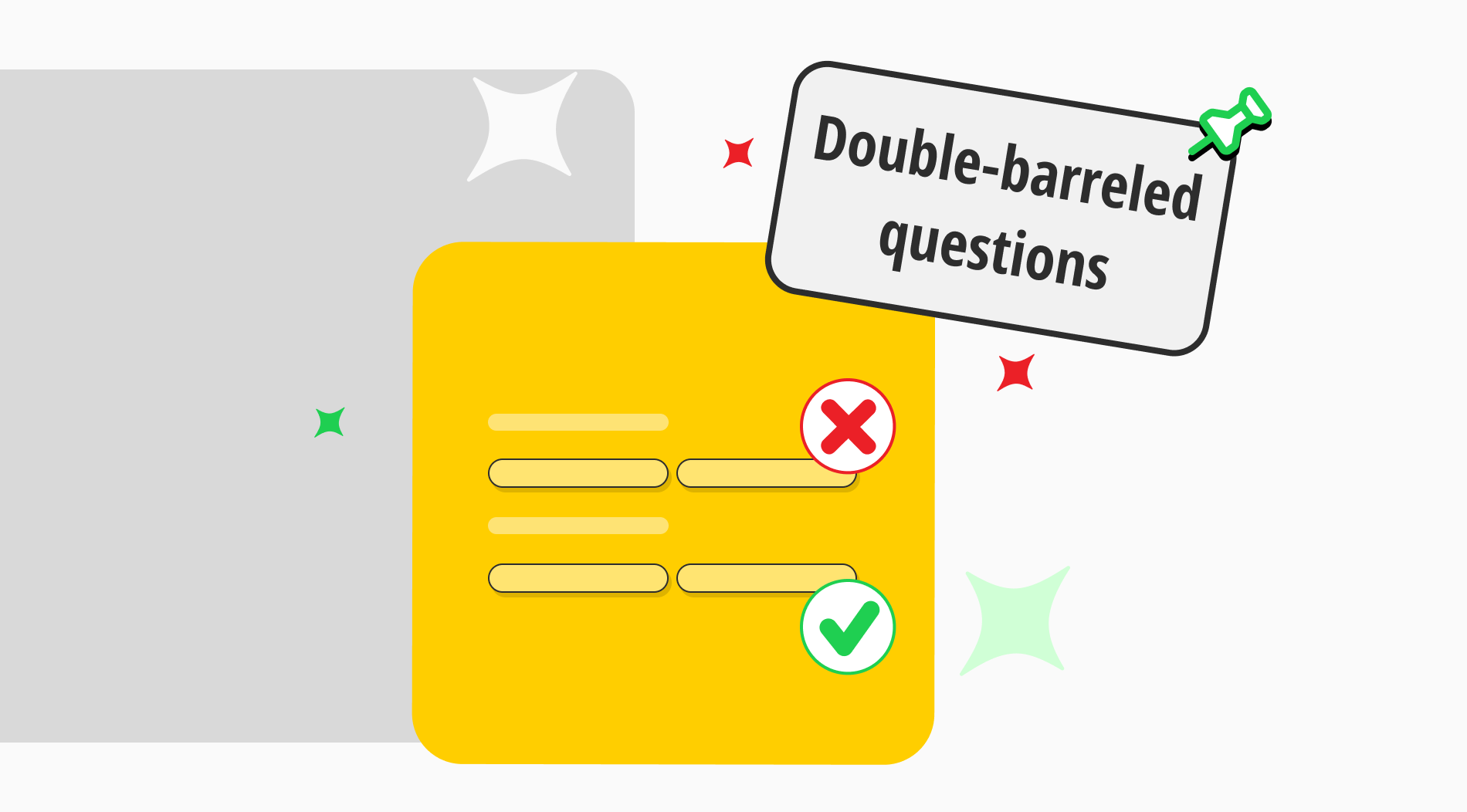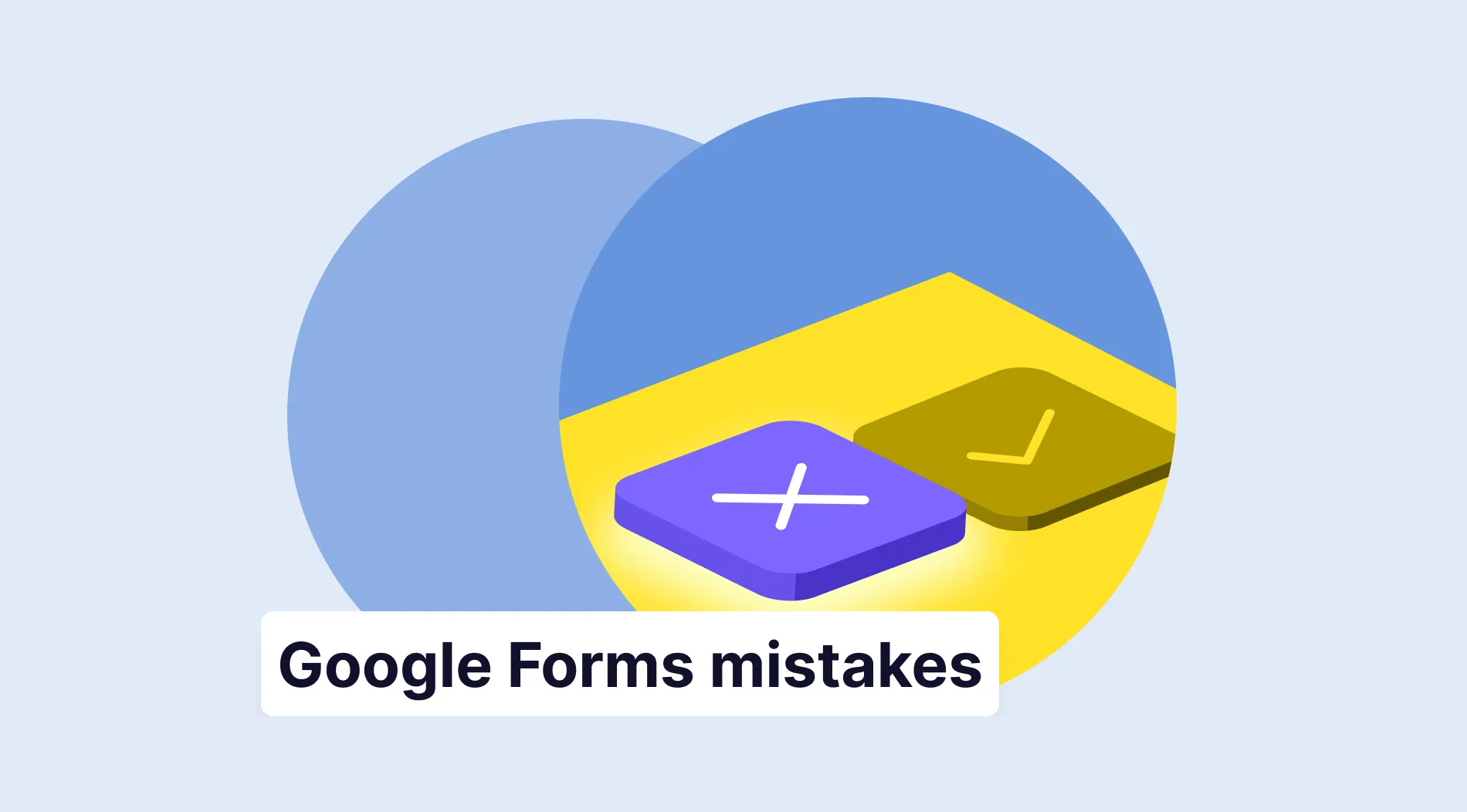Any kind of questionnaires or surveys are done for the sake of collecting valuable data. These data may give you a hand in increasing your success, boosting your power, or finding solutions to problems in your business. However, just preparing a survey alone will not open the doors of success directly to you.
For this reason, it is necessary to follow some ways or avoid mistakes: like double barreled questions. So, if you want to create a successful and useful survey, you need to read this article that explains double barrelled questions in research with examples and more!
What is a double-barreled question?
A double barreled question is a type of question that effectively asks about two separate concerns and spans many topics but only allows for one response. Asking about more than one aspect but wanting them to give a single answer is problematic in the process of gathering data.
The double-barreled question’s fallacy can confuse respondents and not know which one to answer. As long as you avoid using double barreled questions in your survey, you will absolutely get better results and useful data.
Why do you need to avoid double-barreled questions?
The main goal of sharing a survey or questionnaire is to gather reliable, clear, useful, and reasonable data. As we have discussed before, putting random questions in your study will not help you at all; instead, it will lose you time on useless information.
Time is money, and getting what you want directly will assist you. For this reason, if you want to get better survey results, you need to avoid asking double barreled survey questions for healthier business decisions.
10 Double-barreled question examples
Unless the survey creators want to ruin the chances of success or increase the power of the business, avoiding these types of tricky questions is essential. On the following list, we have prepared for you 10 excellent compound questions examples to avoid and how to prevent them:
1. From 1 to 10, how do you rate our service and product?
This customer satisfaction survey question is a good example of a double-barreled question. As you can see from the sentence, the question wants the respondent to answer more than one question. The rate for service and product should be asked separate questions because they are not the same thing. Instead, it can be asked these:
“From 1 to 10, how do you rate our service?”
“From 1 to 10, how do you rate our product?”
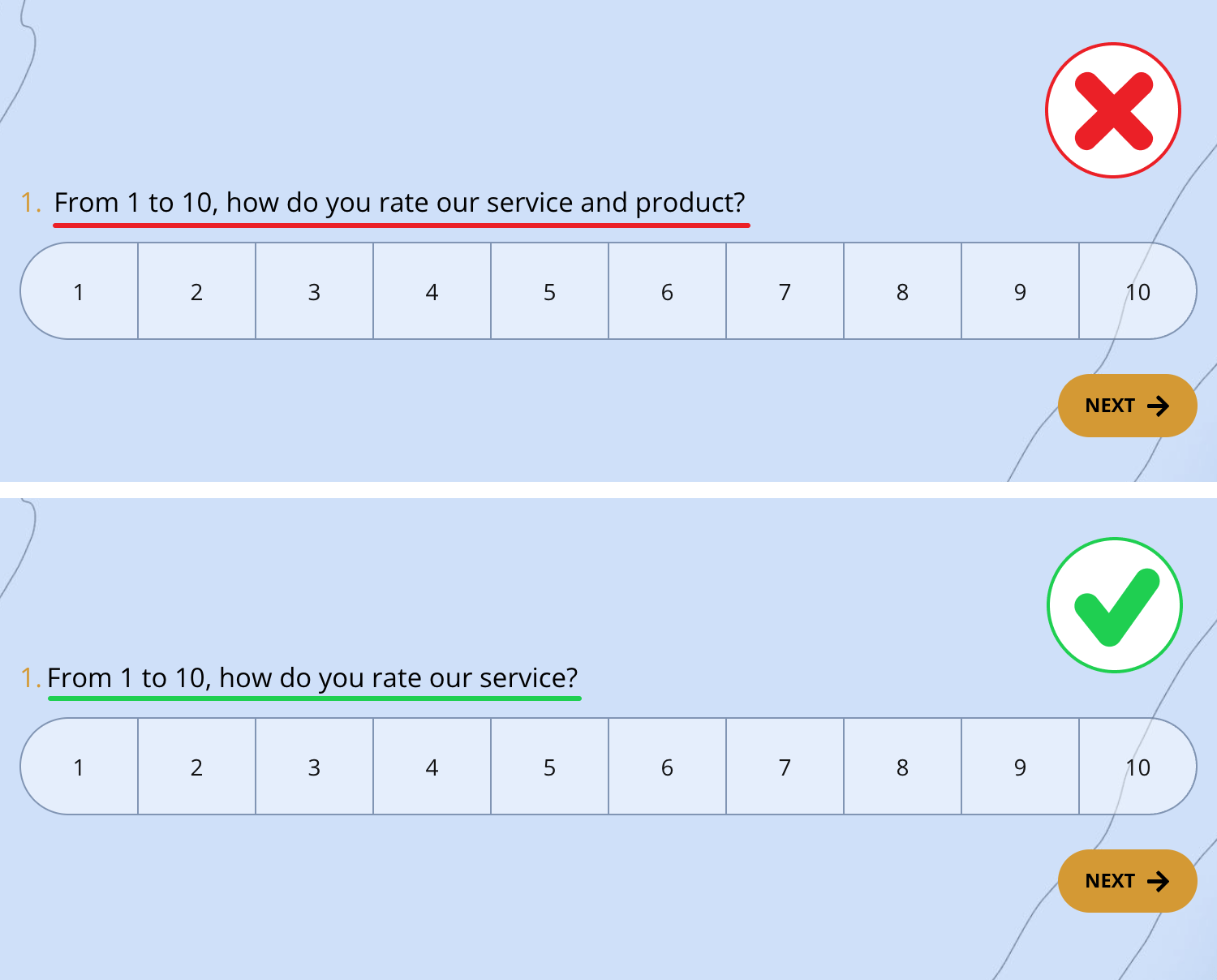
Double-barreled question example #1
2. How often do you visit our website and shop?
Asking this kind of double-direct question that you might use in your 360-degree feedback questionnaire will cause confusion among the survey or questionnaire participants. They might choose to visit the real shop instead of the website, or similarly, they might prefer only the website. To prevent this confusion among the respondents, it should be noted that the questions should make the respondents feel like they have only one option. Instead, try using these:
“How often do you visit our website?”
“How often do you visit our shop?”
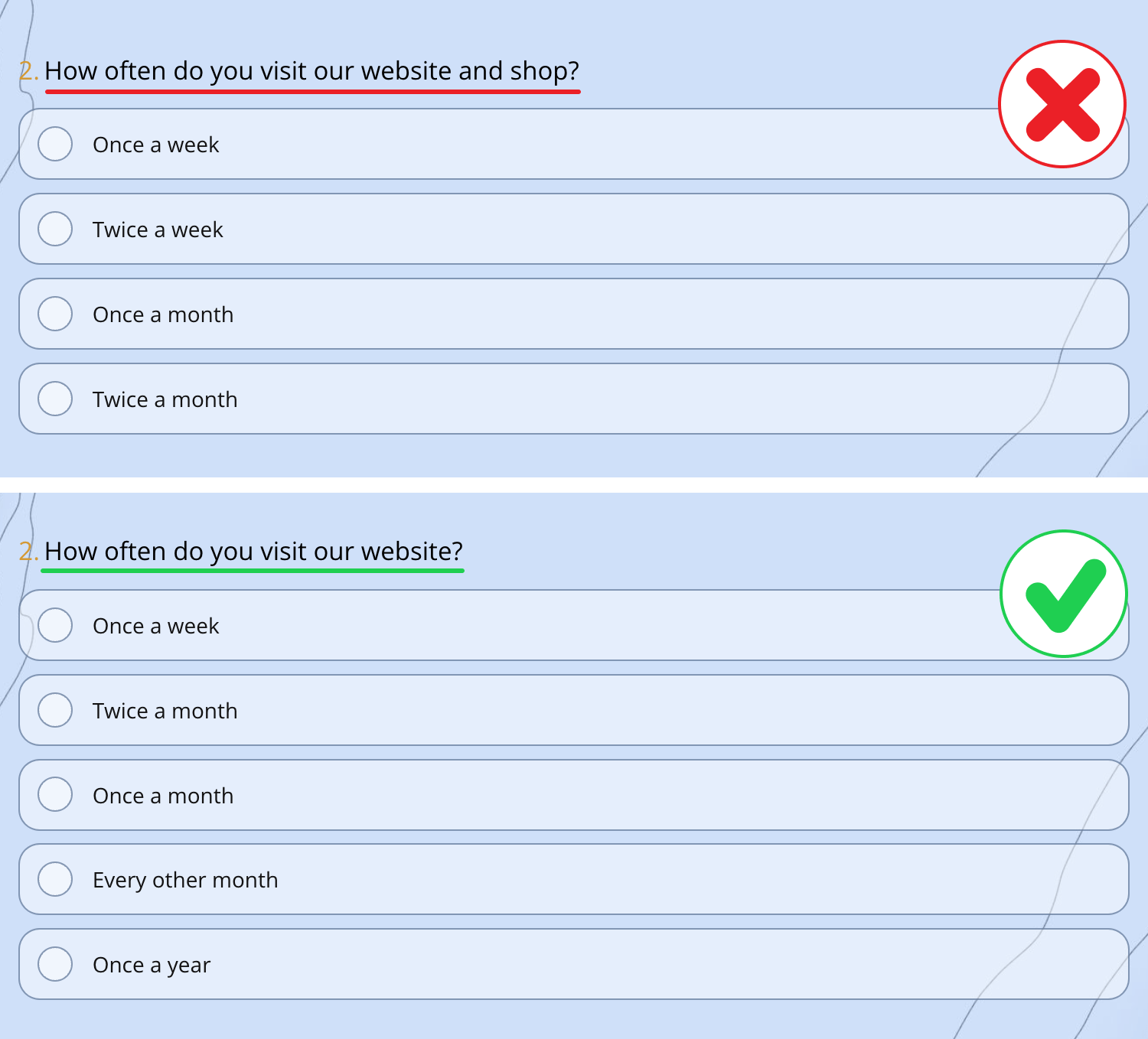
Double-barreled question example #2
3. Do you shop from us weekly or monthly?
Assuming the customers visit, shop, or choose your brand at regular intervals would not be right. The visits do not have to be done regularly, weekly, or monthly. Also, the answers might vary, like yearly, twice a week, three times a month, or every other week. So, your question title should not contain a frequency word like the ones above and instead should look like this:
“How often do you visit our shop?”
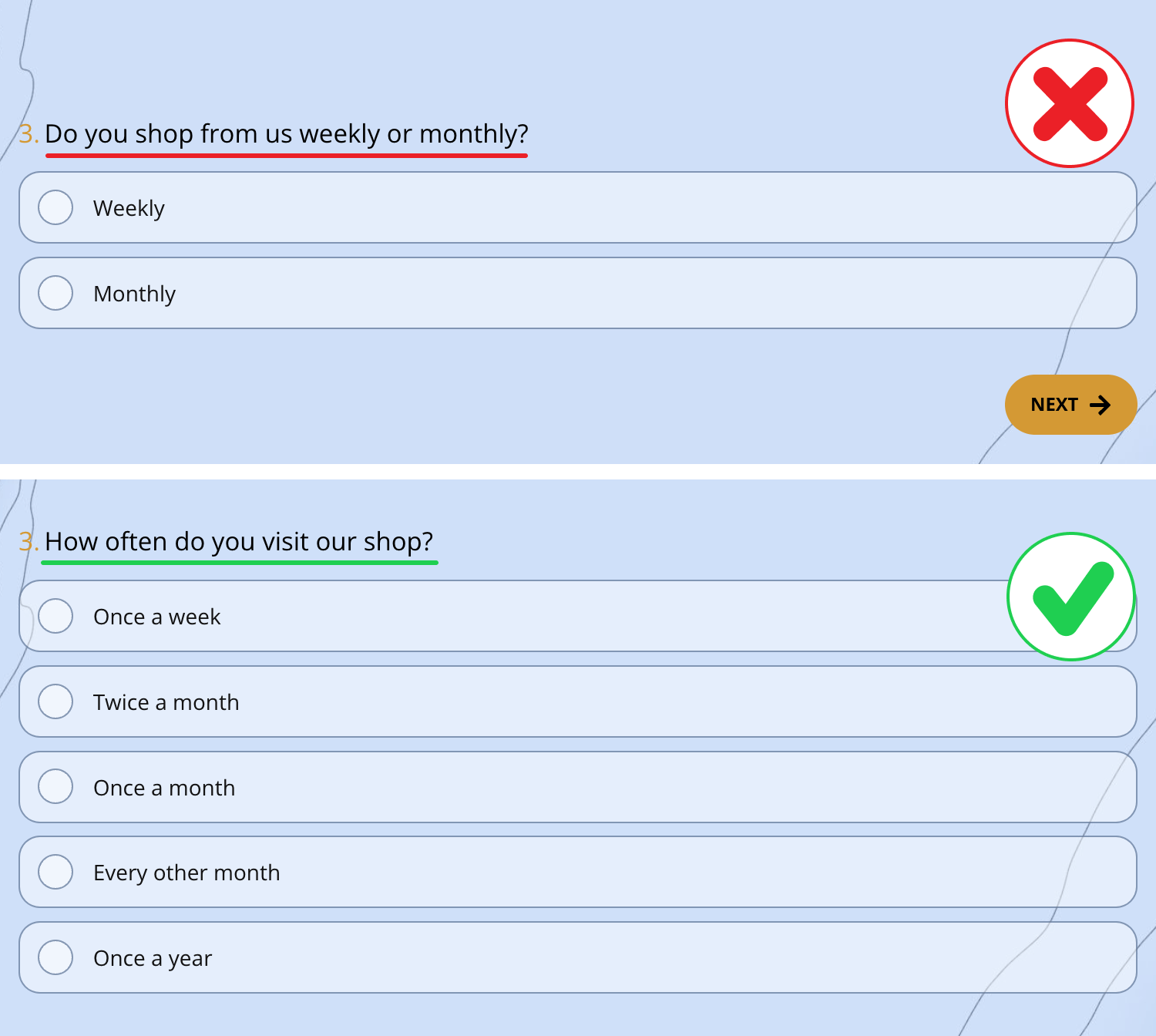
Double-barreled question example #3
4. Do you find our team and environment welcoming?
Evaluating both your team and environment is completely different. For that reason, these two items should not be used in the same sentence. Because while a customer finds your team welcoming, the atmosphere of the environment cannot feel them welcoming, or vice versa. Alternatively, ask these two questions:
“Do you find our team welcoming?”
“Do you find our environment welcoming?”
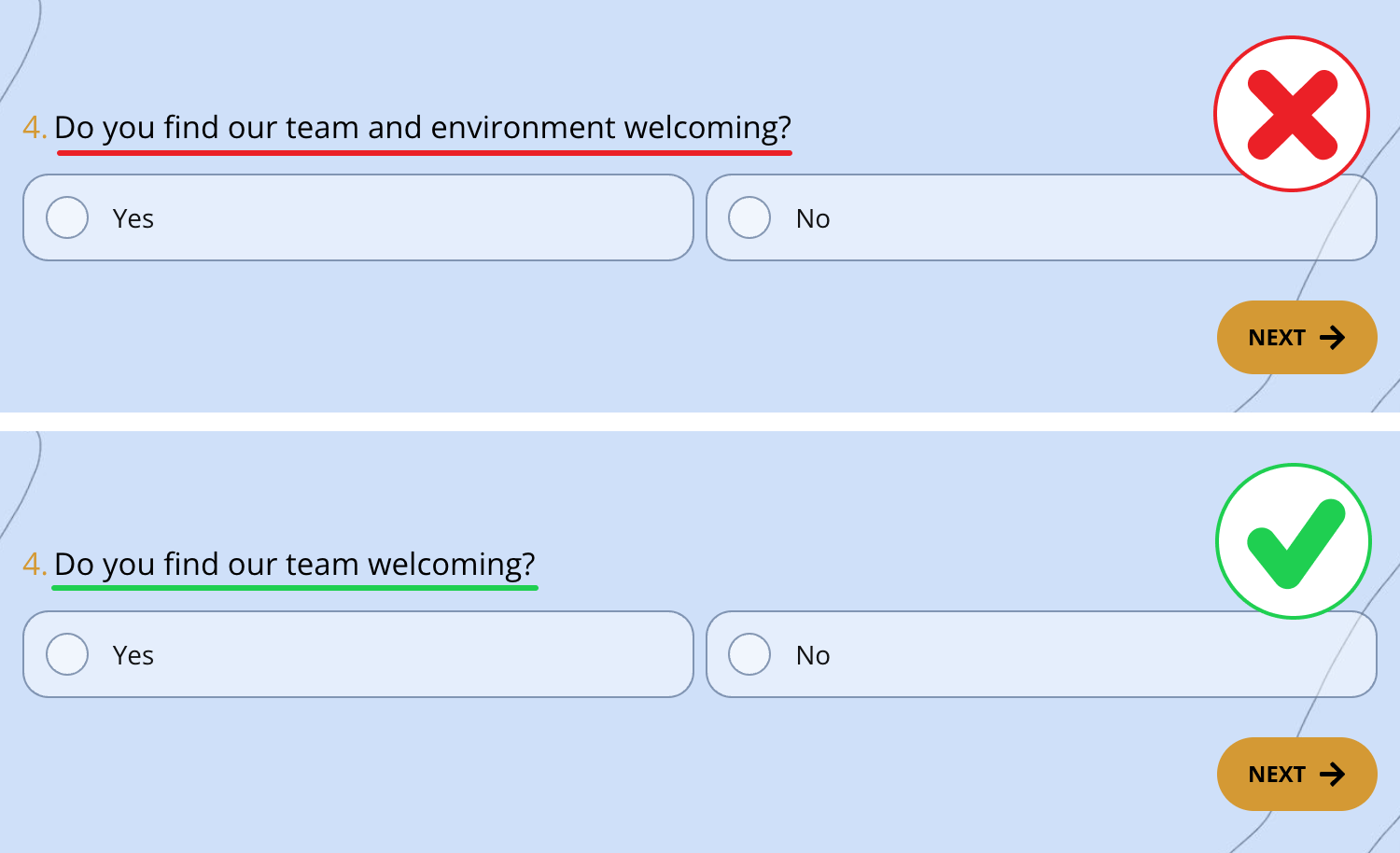
Double-barreled question example #4
5. Did you hear about us via social media or advertisement?
This type of question used in your perception survey can be regarded as a loaded question since it assumes that the customer has only two possibilities for hearing about the brand. They could have heard you from friends, a family member, or a search engine. In order to make them feel freer about the decision, you can ask a multiple choice instead of a single selection as the type of answer option:
“How did you hear from us?”
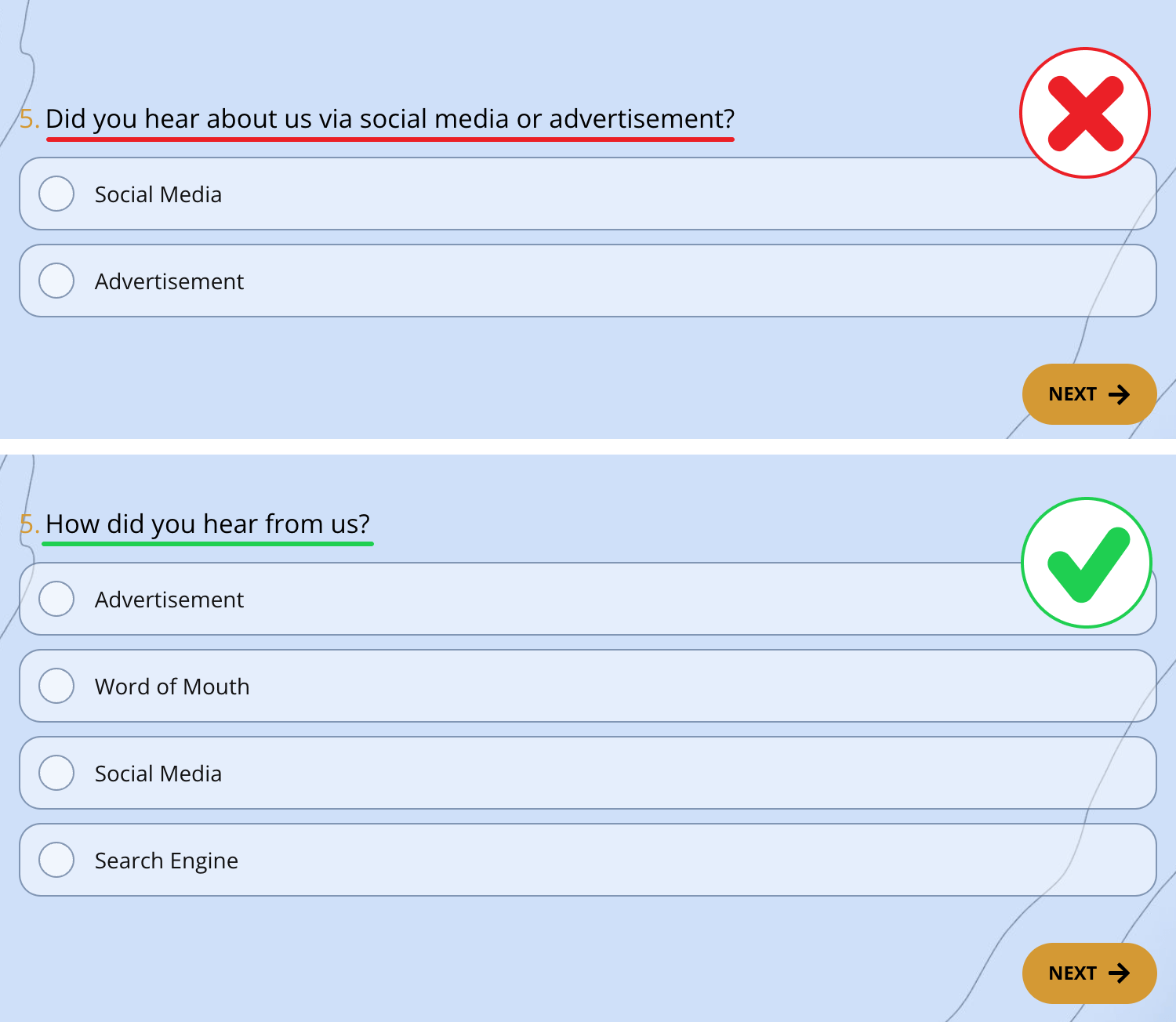
Double-barreled question example #5
6. Do you like the prices or quality of us the most?
There could be more than one reason for customers to choose you. Moreover, the reason might not be found in the question itself. For this reason, it is really essential to ask the proper questions instead of a leading question. In this way, you will be able to collect more honest and accurate answers:
“What do you like about us?”
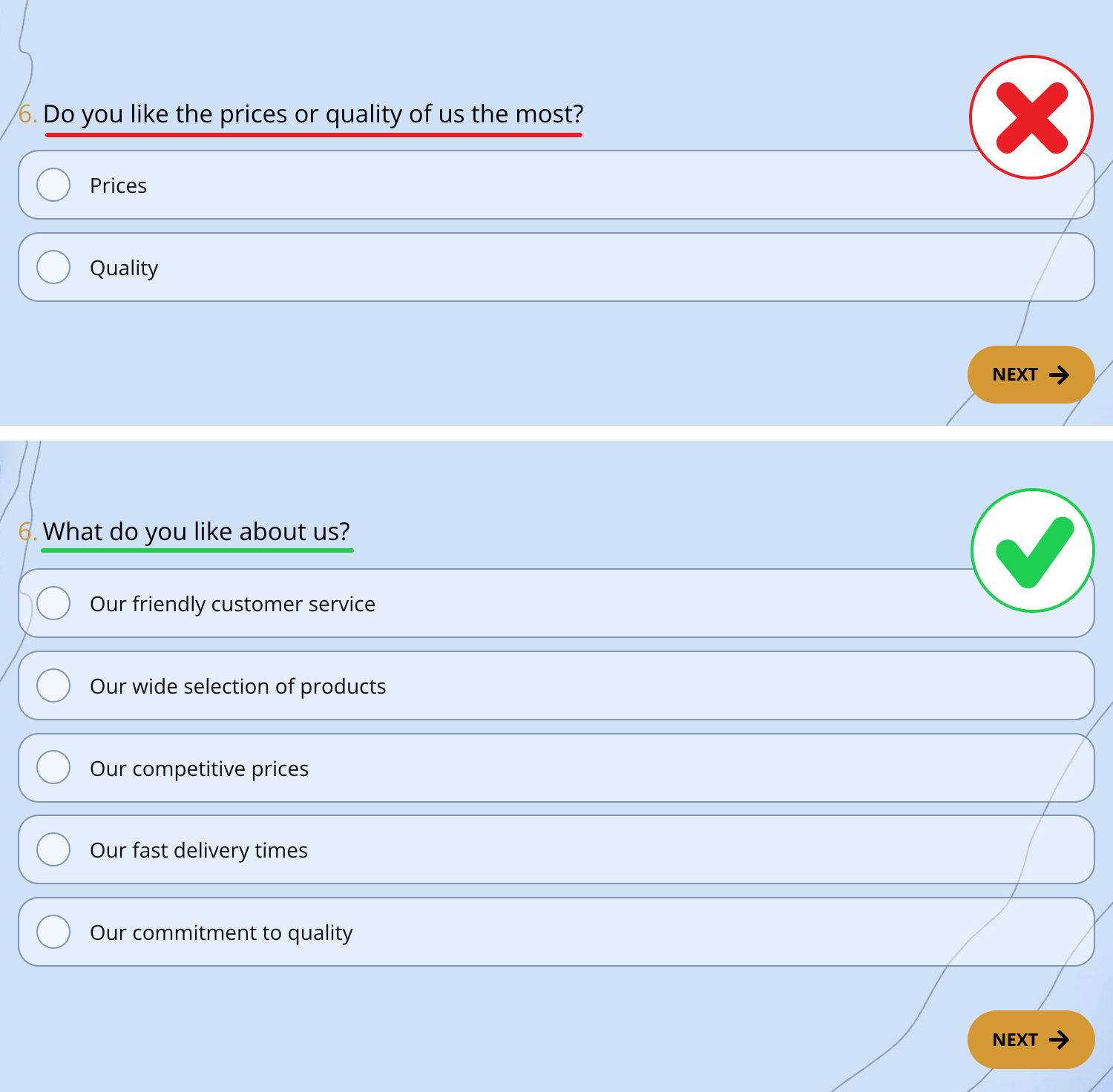
Double-barreled question example #6
7. Do you follow us on Instagram and Twitter?
Regardless of sector, you have a social media account(s) if you have a business or company. Businesses can have accounts on Instagram, Twitter, Facebook, TikTok, YouTube, LinkedIn, Twitch, or Snapchat, which makes more than two. So, you should not limit the question like that; instead, ask:
“In which social media platforms do you follow us?”
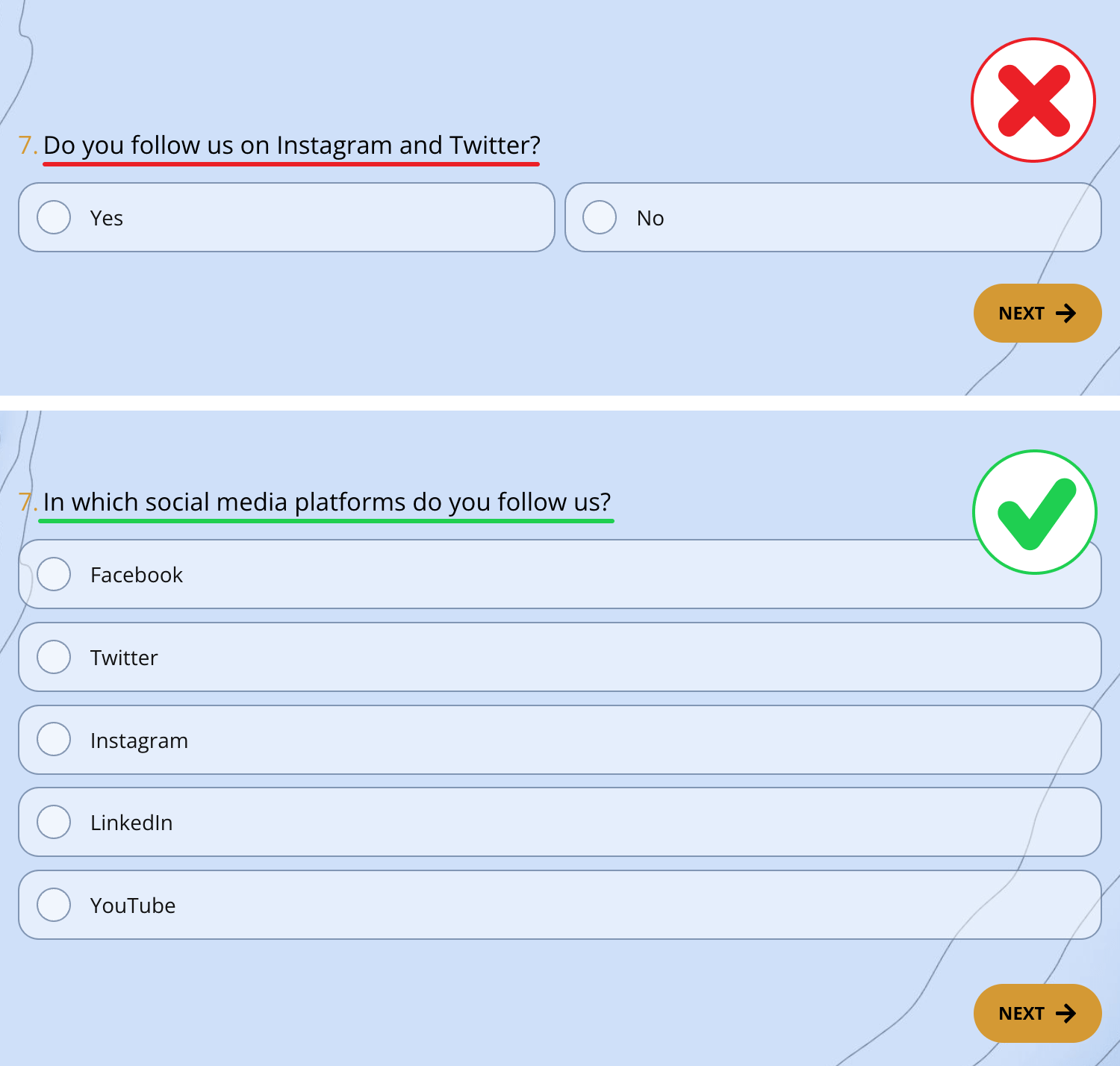
Double-barreled question example #7
8. Do you like the design and colors of our place?
This question is an excellent example of putting pressure on the survey respondents. The favorite or popular sides should not be asked in the questions themselves; instead, they should be presented in the öultimle choice section or open-ended answer. So try using these agree or disagree questions:
“Do you like the design of the place?”
“Do you like the colors of the place?”
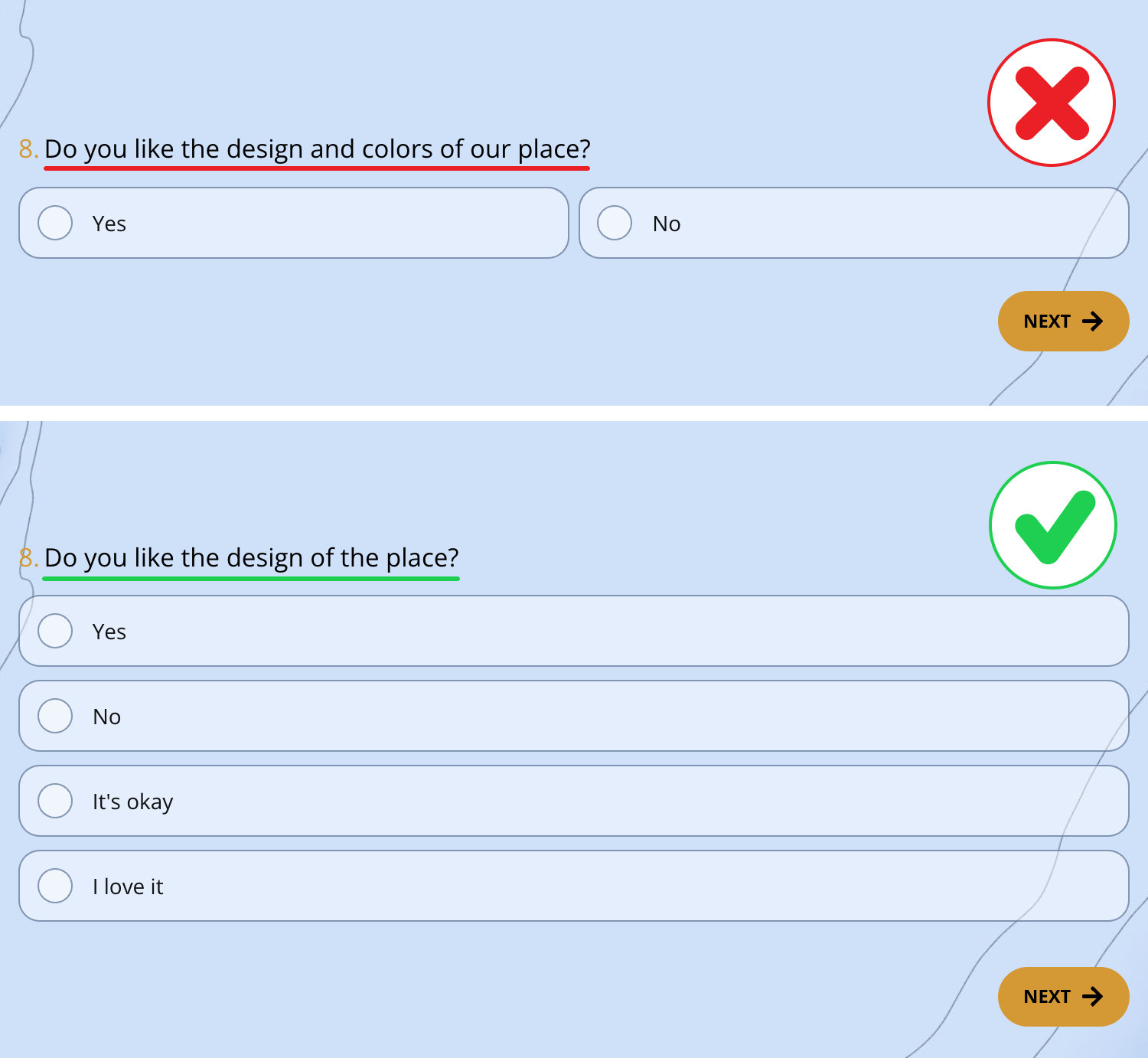
Double-barreled question example #8
9. Are you satisfied with the customer support and tech support?
The two aspects that are asked in the question are different things. For this reason, it would not be okay to judge these two at the same time. While answering the questions, the respondent might consider these two the same thing. Similarly, they should be asked in separate sentences:
“Are you satisfied with the customer support?”
“Are you satisfied with the tech support?”
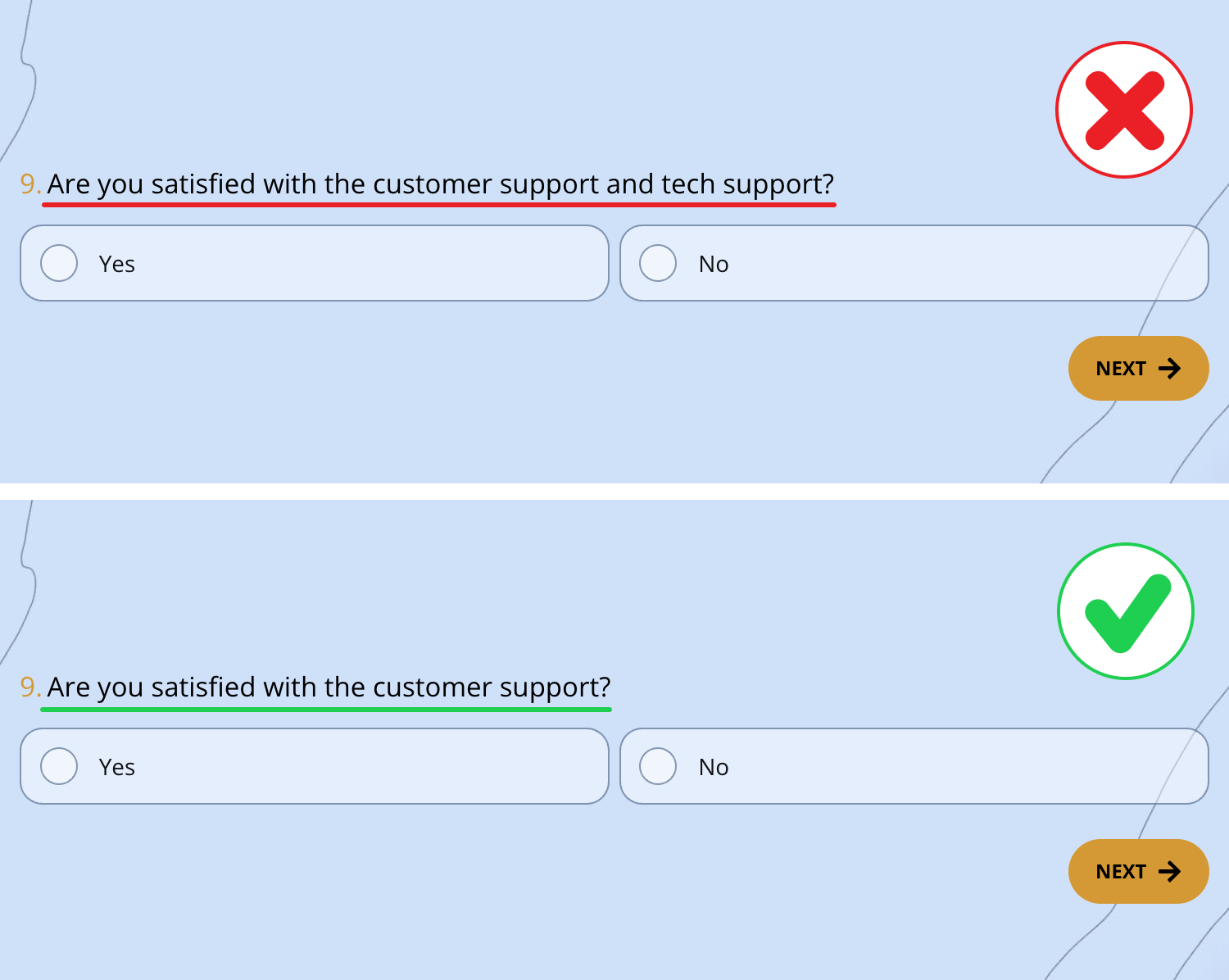
Double-barreled question example #9
10. Do you like our brand?
This question is a good example of ambiguous questions. The problem with the question is that the question is too general. What do you mean by “Do you like our brand?”. Do you mean the level of service, product quality, or customer service rank? The question should be more specialized and aim to gather target data:
“Do you like our brand in terms of…?”
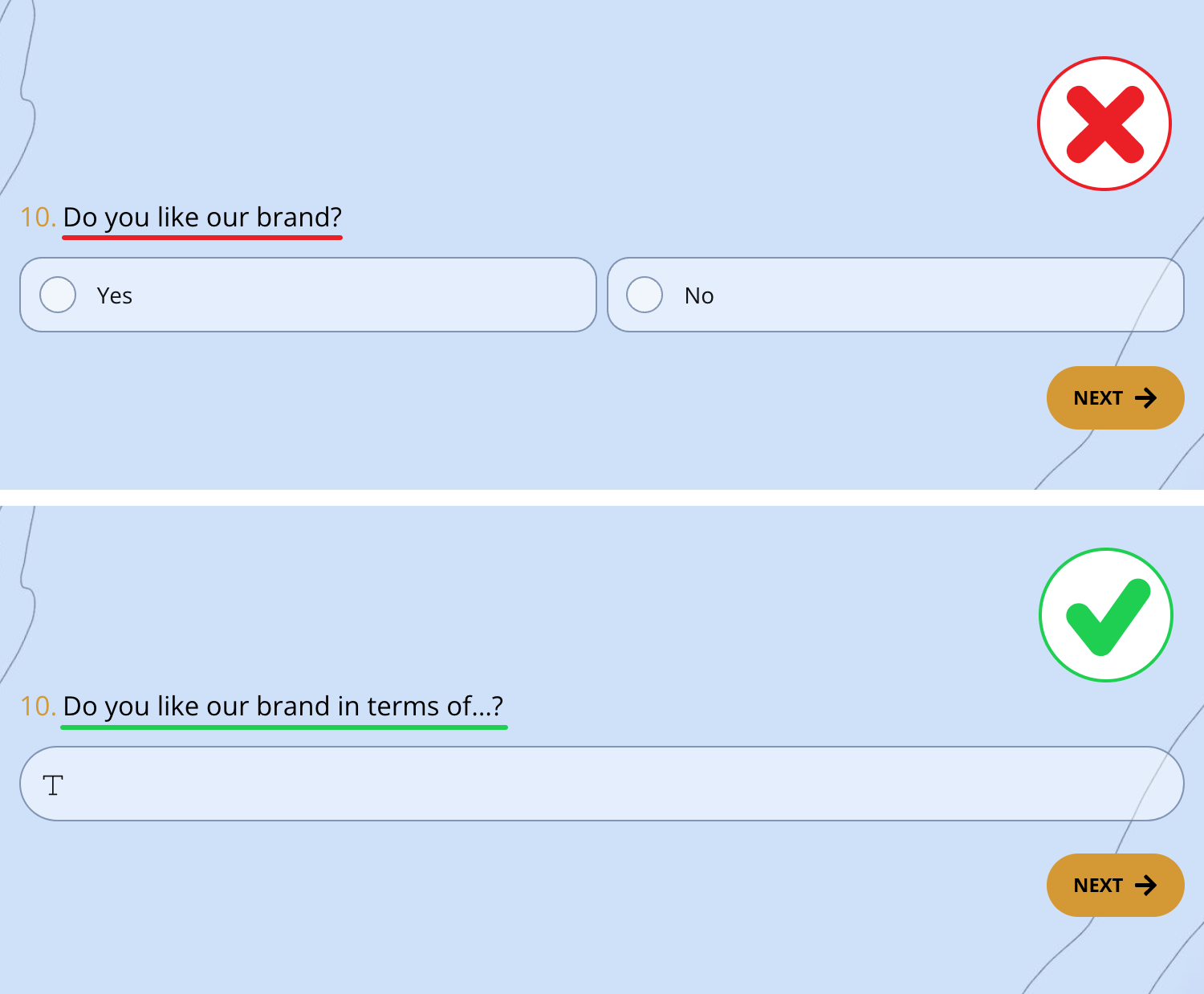
Double-barreled question example #10
How to avoid double-barreled questions (3 things to check)
Despite the fact that double-barreled questions might create confusion among the respondents in the process of answering, there are some tips to follow. As long as the three tips followed carefully given below, you will decrease the number of possible double barreled questions:
1. Set your goal
In the first place, you should definitely aim your goal; otherwise, you will be lost. You need to decide what you want to learn. Do you want to gather feedback about the complaints, learn the most favorable services, most popular products, or test satisfaction? Once you decide what to get at the end of the survey, you will choose your questions better and avoid fewer double-barreled questions.
2. Double-check
There is no harm in double-checking done carefully at all. If you want to prevent double barreled questions, you need to double-check the survey before sharing it. In this way, you will be able to strengthen the reliability and minimize the number of mistakes.
3. Emphasize with the respondents
The key point of a well-prepared survey is to be able to think like the respondents. In this way, in the question creation process, you will be able to realize the sides or parts that you did not realize before. This situation will broaden your horizon and see that double barreled questions are hard to answer.
Other types of question errors
Apart from the double-barreled questions, there are also some kinds of question errors to be avoided: assumptive questions, leading questions, and direct implication questions. They also have misleading sentences that prevent you from collecting data trustworthy and credible. If you want to prevent them, here are some question error types with examples:
Assumptive questions
Assumptive questions rely on assumptions made by the survey’s creator. Once a researcher intends to assess participants’ input on a service or product, they frequently employ assumptive questions in their feedback questionnaires. By asking this type of question, they are taking the respondent’s right to present their opinion freely.
Leading questions
Leading questions combines two linked claims. Even though the respondent does not want to answer both claims, they are being forced to make a decision. This situation will prevent you from gathering healthy data. For this reason, you need to avoid leading questions that limit the respondent.
Direct implication questions
Direct implication questions aim to persuade respondents to think about the outcomes that could occur in the future. To put it another way, direct questions urge respondents to think about the outcomes of their potential response to something. To prevent making them feel pressured, avoid asking this type of question.
Final words
No matter how surveys and questionnaires are regarded as the key to success, there are some points to take away. Double-barreled question is a type of question that needs to be avoided while creating a survey or questionnaire. Similarly, using double negative questions or other types of question errors given above will decrease the quality of your sturdy. Now that you have read here, you know how to avoid double-barreled questions.
forms.app, your free form builder
- Unlimited views
- Unlimited questions
- Unlimited notifications
